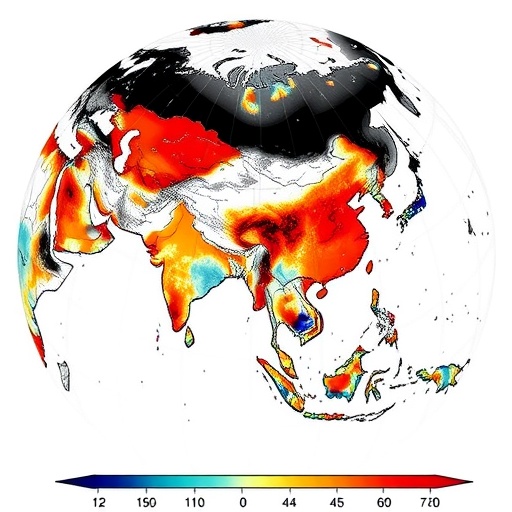High Mountain Asia (HMA) is witnessing dramatic transformations as climate change leads to significant warming and altering weather patterns in the Northern Hemisphere. A groundbreaking study published in the journal Commun Earth Environ highlights the links between the pronounced warming trends in the HMA region and shifts in seasonal weather patterns that affect areas far beyond its mountainous borders. The implications of these findings are vast, as they not only expose the delicate balance of local climates but also hint at a domino effect on global weather systems.
The researchers, led by Xie, Huang, and Wu, employed an extensive dataset, combining historical climate records with modern observational data to analyze weather changes over several decades. Their sophisticated approach not only quantifies the degree of warming in the HMA region but also connects these changes to a notable increase in extreme weather events, including prolonged rainfall and intense heatwaves. The findings suggest that the temperate and polar regions are experiencing unprecedented shifts, and the situation in High Mountain Asia is a critical factor in this global phenomenon.
One of the standout elements of the research is how it maps the rise in temperatures in the high-altitude areas of Asia to changes in atmospheric circulation patterns. The study indicates that the warming amplification observed in HMA is affecting the jet stream, a high-altitude air current that plays a key role in global weather systems. By analyzing how this air current behaves differently in response to varying temperatures, the researchers were able to illustrate that the consequential shifts could result in more extreme weather phenomena across the globe.
The implications for agriculture, water resources, and overall ecosystem health in the HMA region are profound. As temperatures rise, the melting of glaciers which supply water to millions of people and agricultural systems becomes alarmingly rapid. This research points towards a future where water availability may become increasingly erratic, further exacerbating tensions in a region already experiencing socio-political challenges.
Furthermore, the effects are not limited to local concerns; the research suggests a cascading effect on areas far removed from HMA. Changes in precipitation patterns can lead to increased flooding in some regions while leading to droughts in others. Such widespread shifts underscore the interconnectedness of global weather systems and emphasize the need for comprehensive climate action that transcends regional boundaries.
Oceanic patterns also play a significant role in the climate shifts discussed in this study. Variations in sea surface temperatures affect wind patterns, which in turn influence weather cycles in HMA and the surrounding areas. Understanding these connections provides vital insights into how atmospheric interactions can elucidate climatic extremes and the importance of accounting for multiple climatic variables when forecasting future scenarios.
In their analysis, the researchers also discussed the role of feedback mechanisms that may exacerbate existing trends. For instance, the exposure of darker land surfaces as snow and ice retreat may lead to further warming, creating a self-perpetuating cycle of climate change. This is particularly concerning for High Mountain Asia, as the region has been a significant indicator of broader climate trends observed worldwide.
Moreover, the research emphasizes the importance of international collaboration in climate science to address these pressing issues. High Mountain Asia not only serves as a barometer for global warming but also as a vital region for biodiversity. Protecting its ecological integrity is paramount for both regional stability and global climate health. Hence, the study advocates for increased investment in climate resilience strategies, particularly in vulnerable regions.
Policy implications arising from the study are substantial, suggesting a need for immediate action. Governments and international organizations must prioritize the findings of this research in climate adaptation and mitigation strategies. By focusing on the intricacies of how warming in High Mountain Asia affects weather across the Northern Hemisphere, stakeholders can craft more informed policies that take into account these complex interdependencies.
The researchers also highlight the critical role of continued monitoring and data collection in HMA to enhance predictability and response strategies. As modeling and forecasting technology continues to advance, having a robust dataset will be essential for improving our understanding of these critical climate dynamics.
Despite the stark warnings, there is a silver lining. The study emphasizes that it is not too late to implement change. Enhanced global cooperation in addressing climate change can help mitigate some of the most severe implications etched into these findings. Fostering innovation and sustainable practices can rejuvenate affected areas while contributing to a broader global effort against climate change.
In conclusion, this insightful study presents a compelling argument for the urgent need to address climate change through a well-informed and multifaceted approach. The dynamics of weather patterns linked to warming in High Mountain Asia represent a microcosm of a much larger global issue that requires immediate attention and action. The interconnected nature of our climate system illustrates that the efforts to tackle these problems must be as expansive as the challenges themselves.
Subject of Research: Changing Northern Hemisphere weather linked to warming amplification in High Mountain Asia.
Article Title: Changing Northern Hemisphere weather linked to warming amplification in High Mountain Asia.
Article References: Xie, Y., Huang, J., Wu, G. et al. Changing Northern Hemisphere weather linked to warming amplification in High Mountain Asia. Commun Earth Environ 6, 932 (2025). https://doi.org/10.1038/s43247-025-02883-0
Image Credits: AI Generated
DOI: https://doi.org/10.1038/s43247-025-02883-0
Keywords: Climate Change, High Mountain Asia, Weather Patterns, Extreme Weather, Glacial Melt, Atmospheric Circulation, Global Warming, Environmental Policy, Interconnected Climate Systems.




